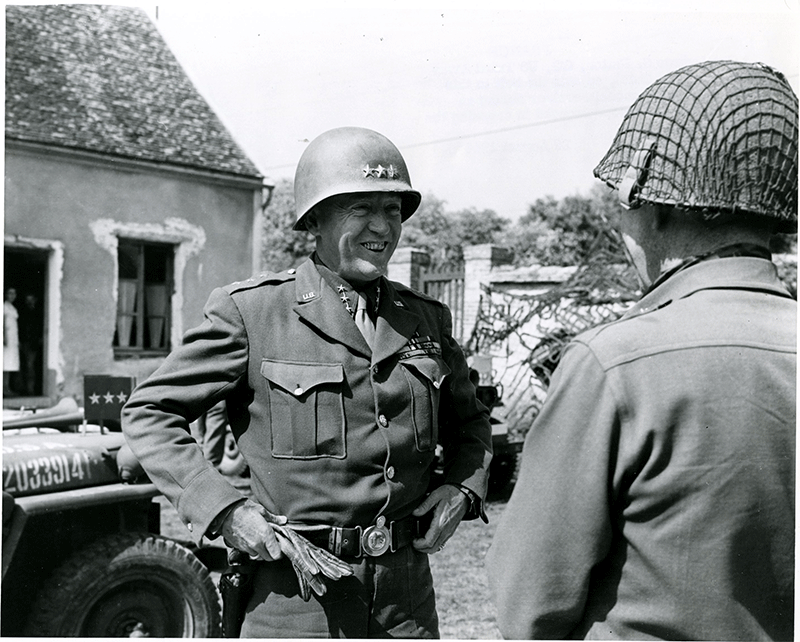4 Star General Takes Polar Bear Plunge in WWII
General George S. Patton, Jr.:
Going off of the Map

by Kevin M. Hymel
During World War II, General George S. Patton rarely let anything impede his progress. In Sicily, when the Germans stymied his drive to Messina, he outflanked them three times from the sea; during the breakout in Normandy, his corps commander, Major General Manton Eddy, turned green when Patton ordered him to advance 50 miles in one day; during the Battle of the Bulge, Patton even stripped down and swam across the Sure River under fire.
I try to keep that spirit alive in my “In Patton’s Footsteps” tour for Stephen Ambrose Historical Tours. Since commencing the tour in 2008, I have adapted it to explore new Patton locations as well as areas where veterans on the tour have been. The eleven-day tour starts in Paris, spends two days in Normandy, explores the breakthrough at Avranches, visits Mont Saint Michel, follows the battles of the Falais Pocket, the German border, the Battle of the Bulge and the assault into Germany. It ends with a visit to Patton’s grave and a drive to the scene of Patton’s car accident that eventually took his life. The 2017 tour kicks off on June 13 and ends on the 24.
My fist tour visited Mortain and then went to Chambios. Then I learned about the battle for Mayenne, a French town bisected by the Mayenne River, with three bridges spanning it. During the war, the Germans destroyed two of the bridges and were preparing to blow the third when Patton’s 90th Infantry Division attacked. I found the story fascinating and decided to include it into the tour. I studied the battle, as well as Google Maps, to figure out where to go, even though I knew I was taking a risk, having never actually been there.
The night before we visited Mayenne, I had nightmares that the bus rolled into the river and there was no bridge to find. That day, I sat nervously next to the driver as we headed into Mayenne. Sure enough, everything was exactly like Google Maps had shown. I even found a memorial plaque on the bridge where one of the Americans had been killed. Mayenne is now a permanent part of the tour and some guests have said it’s their favorite site.

In subsequent tours, I explored Clermont en Argonne, a town where Patton detrained his tanks in World War I, then had his picture t
aken at its train station during World War II (the picture is on page 70 of my book Patton’s Photographs: http://amzn.to/2fh2ibu). The train station is now defunct, but is a popular picture-taking place on the tour, ensuring that my guests are standing in the footsteps of Patton.
My tour spends two days examining the Battle of the Bulge. The first day includes a trip to Clervaux, Luxembourg, to begin following the German attack. The second day follows Lieutenant Colonel Creighton Abrams’ armored drive into Bastogne. To improve the tour, I added a visit to Hosingen to the first day, where the German campaign began. We even found the water tower where American soldiers saw sparkling lights to the east, which turned out to be German artillery pieces firing.
For the second day, I added Lieutenant Colonel Albin Irzyk’s armored drive to Bastogne. Irzyk’s 8th Tank Battalion was thought to be the unit to break through to the 101st Airborne, but some Tigers got in the way. At the handful of hamlets called Chaumont, German Tiger heavy tanks tore into Irzyk’s Sherman medium tanks, putting an end to his drive. Today, the town’s park is named for Irzyk, and a 4th Armored Division memorial on the way into the town marks where a German 88mm round smashed into Irzyks tank and cracked the back of his turret.
In 2010, I was lucky enough to have veteran Harry Cruse and his two sons with my tour group. Cruse served with the 3rd Armored Division and had shot down a German fighter plane in Langlire, Belgium, north of Houffalize. He wanted to return to the town, so I planned a visit, where I could take a picture of Cruse and his sons in front of the town sign. Everyone on the bus agreed to the plan.
We arrived in Langire and found an old barn where Cruse told about shooting down the fighter. Then we reboarded and drove to the outskirts of the town where we found the town sign. As planned, the Cruses and I got off the bus, but just as I was about to take the picture, everyone else filed out of the bus to take their own picture. I realized then that they were just as excited as I was to record this connection with history.
(See how Harry Cruse shot down a German fighter plane here: http://bit.ly/2fjH6le)
Where will the Patton tour take us this year? We will follow in his footsteps as always, but if I come across something in my research, we might have to go off the map and explore something new. I have discovered where Patton swam across the Sure River. That would be a fun place to take Patton admirers. I’d like to think that the General would be proud.
To learn more about the next eleven-day “In Patton’s Footsteps” tour (June 13-24, 2017) contact Stephen Ambrose Historical Tours at 888-903-3329 or visit their website: http://bit.ly/2fh62K1
Kevin M. Hymel is a historian/tour guide for Stephen Ambrose Historical Tours and leads a tour of General George S. Patton’s battlefields. He has authored Patton’s Photographs: War as He Saw It, and Patton: Legendary World War II Commander. He is also the Historian for the U.S. Air Force Chaplain Corps and lives in Arlington, Virginia. He holds a Master’s degree in History from Villanova University.


